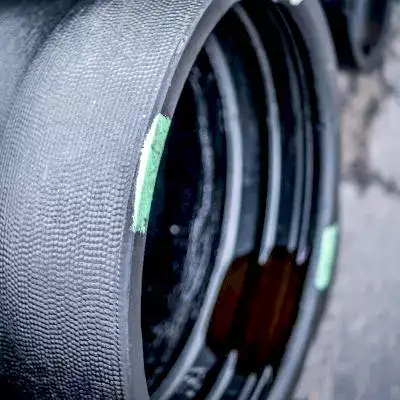Choosing the right tracer wire is crucial for accurately locating underground utilities like gas, water, and electrical lines. But what is the best wire for a tracer wire? Copper-clad steel and HDPE-insulated copper are among the top choices due to their conductivity, durability, and corrosion resistance.

1. Introduction to Tracer Wire
Tracer wire is an essential component in the installation of underground utilities, including water, sewer, and gas lines. It allows for the precise location of buried pipelines using electromagnetic signals. This guide explores the best options for tracer wire, focusing on materials, installation practices, and compliance with industry standards.
2. Importance of Tracer Wire in Ductile Iron Pipe Installation
While ductile iron pipes are conductive, they are often wrapped in polyethylene or exposed to the earth, making them difficult to locate without tracer wire. Tracer wire ensures that these pipelines can be accurately located during maintenance, repairs, or future installations.
3. Key Factors in Selecting Tracer Wire
Material Composition
-
Solid Copper Wire: Offers excellent conductivity and flexibility but is more susceptible to corrosion.
-
Copper-Clad Steel (CCS) Wire: Combines the conductivity of copper with the strength of steel, offering a balance between performance and cost.
Gauge and Strength
The gauge of the wire determines its strength and suitability for different applications. Common gauges include 12 AWG, 14 AWG, and 10 AWG, with lower numbers indicating thicker and stronger wires.
Insulation and Jacket
High molecular weight polyethylene (HMWPE) and high-density polyethylene (HDPE) are commonly used for insulation, providing resistance to moisture, chemicals, and physical abrasion.
Signal Conductivity
The wire’s ability to conduct electromagnetic signals is crucial for accurate location. Materials like CCS and solid copper are preferred for their superior signal conductivity.
Environmental Resistance
Tracer wire must withstand various environmental conditions, including moisture, temperature fluctuations, and soil chemicals. Choosing wire with appropriate insulation and jacket materials ensures longevity and reliability.
4. Top Tracer Wire Options
Solid Copper Wire
-
Pros: High flexibility, excellent conductivity.
-
Cons: Higher cost, more susceptible to corrosion.
-
Best Use: Shorter installations or areas with minimal exposure to corrosive elements.
Copper-Clad Steel (CCS) Wire
-
Pros: Combines conductivity and strength, cost-effective.
-
Cons: Less flexible than solid copper.
-
Best Use: Long-distance installations and areas with potential physical stress.
High-Flexibility Tracer Wire
-
Pros: Enhanced flexibility, suitable for challenging terrains.
-
Cons: May have slightly lower conductivity than solid copper.
-
Best Use: Complex installations with tight bends or obstacles.
Water-Blocking Reinforced Tracer Wire
-
Pros: Designed for direct burial, resistant to moisture ingress.
-
Cons: Heavier, may require more effort during installation.
-
Best Use: Areas with high moisture content or where water resistance is critical.
5. Installation Best Practices
Proper Placement and Spacing
-
Install tracer wire along the length of the buried pipe, maintaining a separation of 2 to 6 inches to prevent direct contact.
-
Use non-metallic spacers to maintain consistent distance from the pipe.
Grounding Techniques
-
At dead ends or stubs, ground the tracer wire using a 1.5-pound magnesium anode with a minimum of 20 feet of lead wire.
-
Ensure grounding is done at both ends of directional drilling installations.
Access Points and Terminations
-
Provide access points at regular intervals, typically every 500 feet, and at all valve locations.
-
Use appropriate access boxes, such as cast iron or concrete grade-level boxes, to protect the wire and allow for future locating.
Testing and Verification
-
Use low-frequency line locating equipment to verify the tracer wire’s functionality.
-
Conduct continuity testing to ensure the wire is continuous and without breaks.
6. Common Challenges and Solutions
Challenge 1: Wire Corrosion
Solution: Use corrosion-resistant materials like CCS or wires with protective coatings to prevent degradation.
Challenge 2: Physical Damage During Installation
Solution: Handle wires carefully during installation and use protective measures like conduit or shielding in high-risk areas.
Challenge 3: Inaccurate Location Signals
Solution: Ensure proper grounding and use high-quality wire materials to maintain strong and accurate signals.
7. Case Studies
Case Study 1: Urban Water Distribution System
In a metropolitan area, the installation of CCS tracer wire along ductile iron water mains allowed for accurate location during maintenance, reducing downtime and repair costs.
Case Study 2: Rural Sewer Line Installation
For a rural sewer project, high-flexibility tracer wire was used to navigate challenging terrain, ensuring reliable location capabilities despite the complex landscape.
8. Frequently Asked Questions (FAQs)
8.1 What is the purpose of tracer wire?
Tracer wire is used to locate buried pipelines by conducting electromagnetic signals, aiding in maintenance and future installations.
8.2 Can ductile iron pipes be located without tracer wire?
While ductile iron pipes are conductive, they are often wrapped or exposed to the earth, making them difficult to locate without tracer wire.
8.3 What is the best material for tracer wire?
Copper-Clad Steel (CCS) wire offers a balance between conductivity, strength, and cost, making it a popular choice for many installations.
8.4 How often should tracer wire be tested?
Tracer wire should be tested during installation and periodically thereafter, especially before major maintenance or excavation work.
8.5 Can tracer wire be spliced?
Splicing is possible but should be done using approved connectors to maintain electrical continuity and mechanical strength.
8.6 What are the color codes for tracer wire?
Color codes vary by utility type; for example, green is commonly used for sewer lines, blue for potable water, and yellow for gas lines.
9. Conclusion
Selecting the appropriate tracer wire is crucial for the reliable location of underground utilities. Consider factors like material composition, gauge, insulation, and environmental resistance to choose the best wire for your specific application. Adhering to installation best practices ensures the longevity and functionality of the tracer wire system.
